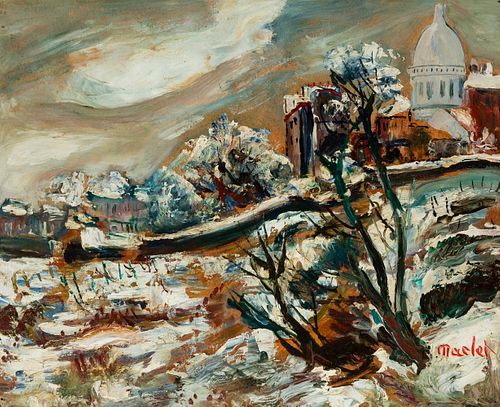ELISÉE MACLET (Lyons-en-Santerre, 1881 - Paris 1962). "La butte de Montmartre sans la neige" (The hill of Montmartre without the snow). Oil on cardb
Lot 29
About Seller
Setdart Auction House
Carrer Aragó 346
Barcelona
Spain
Setdart Subastas was born in 2004 and is currently the first online art auction in Spain with solidity, prestige and reliability guaranteed by our more than 60,000 users. Setdart has a young, dynamic and enterprising team ready to successfully manage the purchase and sale of art works through custom...Read more
Estimate:
EUR€2,500 - EUR€2,800
$2,631.58 - $2,947.37
Absentee vs Live bid
Two ways to bid:
- Leave a max absentee bid and the platform will bid on your behalf up to your maximum bid during the live auction.
- Bid live during the auction and your bids will be submitted real-time to the auctioneer.
Bid Increments
| Price | Bid Increment |
|---|---|
| EUR€0 | EUR€10 |
| EUR€200 | EUR€25 |
| EUR€500 | EUR€50 |
| EUR€1,000 | EUR€100 |
| EUR€3,000 | EUR€200 |
| EUR€5,000 | EUR€500 |
| EUR€10,000 | EUR€1,000 |
| EUR€20,000 | EUR€2,000 |
| EUR€50,000 | EUR€5,000 |
About Auction
By Setdart Auction House
Oct 27, 2021
Set Reminder
2021-10-27 10:00:00
2021-10-27 10:00:00
America/New_York
Bidsquare
Bidsquare : 19th & 20th Century Paintings & Decorative Arts
https://www.bidsquare.com/auctions/setdart-auction-house/19th-20th-century-paintings-decorative-arts-7767
Setdart Auction House sofia@setdart.com
Setdart Auction House sofia@setdart.com
- Lot Description
ELISÉE MACLET (Lyons-en-Santerre, 1881 - Paris 1962). "La butte de Montmartre sans la neige" (The hill of Montmartre without the snow). Oil on cardboard. Signed in the lower right corner. Titled on the back. Measurements: 37 x 44,5 cm; 53,5 x 62 cm (frame). The Parisian district of Montmartre inspired deeply the young and promising Elisée Maclet, recently landed in the French capital in 1906. Sceneries such as the cabarets of Lapin Agile or the Moulin de la Galette, the Sacré Coeur Basilica, the streets of old Paris or the views of the Seine River were masterfully immortalized by Maclet, through a post-impressionist style of a certain childlike simplicity. Considered a key figure in the development of the style of the painter Maurice Utrillo, a firm representative of the Montmartre life of 1900, Elisée Maclet left an important artistic mark on the Paris of the time. As his success grew in Parisian social circles, his artistic role solidified, to the point that the great Parisian gallery owners hung his works alongside those of Van Gogh and Picasso. On this occasion, Elisée Maclet gives us a view of the emblematic Montmartre hill with the Sacré Coeur Basilica in the background, one of the most repeated sites by the artists of the time. In it, the painter captures the underlying essence of one of the most magical places in the French capital, through a daring technique and a totally harmonious and matching color palette, determined by the melting snow. Élisée Maclet initially developed a "primitivist" style of painting that would earn him a place among the "naïff" painters of the beginning of the century. In 1906, Maclet moved to Paris. There he settled in the Montmartre district and produced most of the landscape and street scenes for which he is best known. Maclet's Parisian scenes were successful, especially after World War I, and he maintained this success for the rest of his career because of the unique sensibility and original techniques he demonstrated in his works. Many of the French writers appreciated his paintings and often wrote about him, including Max Jacob, Sidonie Gabrielle Colette, and Francis Carco. From 1918 to 1919, Maclet painted seascapes in Dieppe, living in a house that Carco lent him. He returned to Montmartre in 1919. In 1920, the art dealer, Dosbourg, bought some of his early Montmartre scenes. He lived in Arles from 1923 to 1928, where he painted many remarkable landscapes expressing his enchantment with nature and Mediterranean culture, some of which are sometimes reminiscent of Matisse. In 1928, Maclet received his first major solo exhibition, held at the Gallerie Barreiro in Paris, where more than 50 of his works were exhibited. At the end of the year, he left mainland France on a painting excursion to the island of Corsica. He then went to Brittany, where he lived and worked in 1929 and 1930. In 1957 the first major retrospective of Maclet's work was held at the Nicolas Poussin Gallery in Paris, and in 1960 the same gallery presented his work in its "20th Century Paintings" exhibition; another major retrospective took place in 1961, at the Thibaut Gallery in New York City. In the period following his international breakthrough, Maclet was the subject of numerous magazine articles and, over time, several public collections in Europe and America acquired examples of his work, including museums in Chicago, Bremen, Geneva, Sweden, Norway and Monte. After his death in 1962, Maclet posthumously received several international tributes, including solo exhibitions in Paris, Germany, and Venezuela, as well as a prominent exhibition at the Vestart Galleries in New York City in 1969. In 2011, the National Gallery of Bermuda mounted a solo exhibition of his work.
- Shipping Info
-
In-house shipping available. Please inquire at admin@setdart.com.
-
- Buyer's Premium



 EUR
EUR CAD
CAD AUD
AUD GBP
GBP MXN
MXN HKD
HKD CNY
CNY MYR
MYR SEK
SEK SGD
SGD CHF
CHF THB
THB















